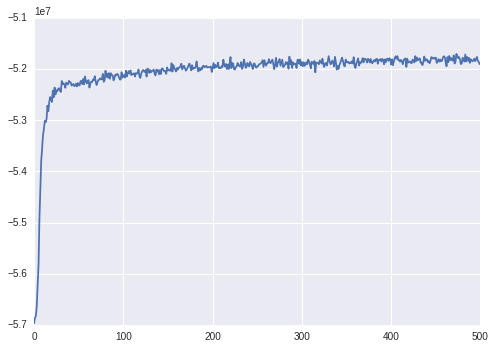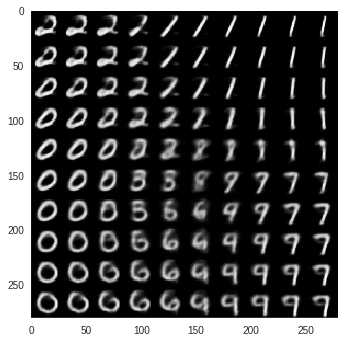Convolutional variational autoencoder with PyMC3 and Keras¶
Last update: 5 November, 2016
- Taku Yoshioka
In this document, I will show how autoencoding variational Bayes (AEVB) works in PyMC3’s automatic differentiation variational inference (ADVI). The example here is borrowed from Keras example, where convolutional variational autoencoder is applied to the MNIST dataset. The network architecture of the encoder and decoder are completely same. However, PyMC3 allows us to define the probabilistic model, which combines the encoder and decoder, in the way by which other general probabilistic models (e.g., generalized linear models), rather than directly implementing of Monte Carlo sampling and the loss function as done in the Keras example. Thus I think the framework of AEVB in PyMC3 can be extended to more complex models such as latent dirichlet allocation.
NOTE: This notebook ran with my folk of PyMC3 https://github.com/taku-y/pymc3/tree/advi_refactor.
For using Keras with PyMC3, we need to choose Theano Theano as the backend of Keras.
In [1]:
%autosave 0
%matplotlib inline
import sys, os
sys.path.insert(0, os.path.expanduser('~/work/git/github/Theano/Theano'))
sys.path.insert(0, os.path.expanduser('~/work/git/github/taku-y/pymc3'))
os.environ['KERAS_BACKEND'] = 'theano'
from theano import config
config.floatX = 'float32'
config.optimizer = 'fast_compile'
from collections import OrderedDict
from keras.layers import InputLayer, BatchNormalization, Dense, Convolution2D, Deconvolution2D, Activation, Flatten, Reshape
import numpy as np
import pymc3 as pm
from pymc3.variational import advi_minibatch
from theano import shared, config, function, clone, pp
import theano.tensor as tt
import keras
import matplotlib
import matplotlib.pyplot as plt
import matplotlib.gridspec as gridspec
import seaborn as sns
from keras import backend as K
K.set_image_dim_ordering('th')
Autosave disabled
Using Theano backend.
Load images¶
MNIST dataset can be obtained by scikit-learn API. The dataset contains images of digits.
In [2]:
from sklearn.datasets import fetch_mldata
mnist = fetch_mldata('MNIST original')
print(mnist.keys())
data = mnist['data'].reshape(-1, 1, 28, 28).astype('float32')
data /= np.max(data)
dict_keys(['data', 'COL_NAMES', 'DESCR', 'target'])
Use Keras¶
We define a utility function to get parameters from Keras models. Since we have set the backend to Theano, parameter objects are obtained as shared variables of Theano.
In the code, ‘updates’ are expected to include update objects
(dictionary of pairs of shared variables and update equation) of scaling
parameters of batch normalization. While not using batch normalization
in this example, if we want to use it, we need to pass these update
objects as an argument of theano.function() inside the PyMC3 ADVI
function. The current version of PyMC3 does not support it, it is easy
to modify (I want to send PR in future).
The learning phase below is used for Keras to known the learning phase, training or test. This information is important also for batch normalization.
In [3]:
from keras.models import Sequential
from keras.layers import Dense, BatchNormalization
def get_params(model):
"""Get parameters and updates from Keras model
"""
shared_in_updates = list()
params = list()
updates = dict()
for l in model.layers:
attrs = dir(l)
# Updates
if 'updates' in attrs:
updates.update(l.updates)
shared_in_updates += [e[0] for e in l.updates]
# Shared variables
for attr_str in attrs:
attr = getattr(l, attr_str)
if type(attr) is tt.sharedvar.TensorSharedVariable:
if attr is not model.get_input_at(0):
params.append(attr)
return list(set(params) - set(shared_in_updates)), updates
# This code is required when using BatchNormalization layer
keras.backend.theano_backend._LEARNING_PHASE = \
shared(np.uint8(1), name='keras_learning_phase')
Encoder and decoder¶
First, we define the convolutional neural network for encoder using Keras API. This function returns a CNN model given the shared variable representing observations (images of digits), the dimension of latent space, and the parameters of the model architecture.
In [4]:
def cnn_enc(xs, latent_dim, nb_filters=64, nb_conv=3, intermediate_dim=128):
"""Returns a CNN model of Keras.
Parameters
----------
xs : theano.tensor.sharedvar.TensorSharedVariable
Input tensor.
latent_dim : int
Dimension of latent vector.
"""
input_layer = InputLayer(input_tensor=xs,
batch_input_shape=xs.get_value().shape)
model = Sequential()
model.add(input_layer)
cp1 = {'border_mode': 'same', 'activation': 'relu'}
cp2 = {'border_mode': 'same', 'activation': 'relu', 'subsample': (2, 2)}
cp3 = {'border_mode': 'same', 'activation': 'relu', 'subsample': (1, 1)}
cp4 = cp3
model.add(Convolution2D(1, 2, 2, **cp1))
model.add(Convolution2D(nb_filters, 2, 2, **cp2))
model.add(Convolution2D(nb_filters, nb_conv, nb_conv, **cp3))
model.add(Convolution2D(nb_filters, nb_conv, nb_conv, **cp4))
model.add(Flatten())
model.add(Dense(intermediate_dim, activation='relu'))
model.add(Dense(2 * latent_dim))
return model
Then we define a utility class for encoders. This class does not depend
on the architecture of the encoder except for input shape (tensor4
for images), so we can use this class for various encoding networks.
In [5]:
class Encoder:
"""Encode observed images to variational parameters (mean/std of Gaussian).
Parameters
----------
xs : theano.tensor.sharedvar.TensorSharedVariable
Placeholder of input images.
dim_hidden : int
The number of hidden variables.
net : Function
Returns
"""
def __init__(self, xs, dim_hidden, net):
model = net(xs, dim_hidden)
self.model = model
self.xs = xs
self.out = model.get_output_at(-1)
self.means = self.out[:, :dim_hidden]
self.lstds = self.out[:, dim_hidden:]
self.params, self.updates = get_params(model)
self.enc_func = None
self.dim_hidden = dim_hidden
def _get_enc_func(self):
if self.enc_func is None:
xs = tt.tensor4()
means = clone(self.means, {self.xs: xs})
lstds = clone(self.lstds, {self.xs: xs})
self.enc_func = function([xs], [means, lstds])
return self.enc_func
def encode(self, xs):
# Used in test phase
keras.backend.theano_backend._LEARNING_PHASE.set_value(np.uint8(0))
enc_func = self._get_enc_func()
means, _ = enc_func(xs)
return means
def draw_samples(self, xs, n_samples=1):
"""Draw samples of hidden variables based on variational parameters encoded.
Parameters
----------
xs : numpy.ndarray, shape=(n_images, 1, height, width)
Images.
"""
# Used in test phase
keras.backend.theano_backend._LEARNING_PHASE.set_value(np.uint8(0))
enc_func = self._get_enc_func()
means, lstds = enc_func(xs)
means = np.repeat(means, n_samples, axis=0)
lstds = np.repeat(lstds, n_samples, axis=0)
ns = np.random.randn(len(xs) * n_samples, self.dim_hidden)
zs = means + np.exp(lstds) * ns
return ns
In a similar way, we define the decoding network and a utility class for decoders.
In [6]:
def cnn_dec(zs, minibatch_size, nb_filters=64, nb_conv=3, dim_hidden=100, output_shape=(1, 28, 28)):
"""Returns a CNN model of Keras.
Parameters
----------
zs : theano.tensor.var.TensorVariable
Input tensor.
"""
input_layer = InputLayer(input_tensor=zs,
batch_input_shape=zs.tag.test_value.shape)
model = Sequential()
model.add(input_layer)
model.add(Dense(dim_hidden, activation='relu'))
model.add(Dense(nb_filters * 14 * 14, activation='relu'))
cp1 = {'border_mode': 'same', 'activation': 'relu', 'subsample': (1, 1)}
cp2 = cp1
cp3 = {'border_mode': 'valid', 'activation': 'relu', 'subsample': (2, 2)}
cp4 = {'border_mode': 'valid', 'activation': 'sigmoid'}
output_shape_ = (minibatch_size, nb_filters, 14, 14)
model.add(Reshape(output_shape_[1:]))
model.add(Deconvolution2D(nb_filters, nb_conv, nb_conv, output_shape_, **cp1))
model.add(Deconvolution2D(nb_filters, nb_conv, nb_conv, output_shape_, **cp2))
output_shape_ = (minibatch_size, nb_filters, 29, 29)
model.add(Deconvolution2D(nb_filters, 2, 2, output_shape_, **cp3))
model.add(Convolution2D(1, 2, 2, **cp4))
return model
In [7]:
class Decoder:
"""Decode hidden variables to images.
Parameters
----------
zs : Theano tensor
Hidden variables.
"""
def __init__(self, zs, net):
model = net(zs, dim_hidden)
self.model = model
self.zs = zs
self.out = model.get_output_at(-1)
self.params, self.updates = get_params(model)
self.dec_func = None
def _get_dec_func(self):
if self.dec_func is None:
zs = tt.matrix()
xs = clone(self.out, {self.zs: zs})
self.dec_func = function([zs], xs)
return self.dec_func
def decode(self, zs):
"""Decode hidden variables to images.
An image consists of the mean parameters of the observation noise.
Parameters
----------
zs : numpy.ndarray, shape=(n_samples, dim_hidden)
Hidden variables.
"""
# Used in test phase
keras.backend.theano_backend._LEARNING_PHASE.set_value(np.uint8(0))
return self._get_dec_func()(zs)
Generative model¶
We can construct the generative model with PyMC3 API and the functions and classes defined above. We set the size of mini-batches to 100 and the dimension of the latent space to 2 for visualization.
In [8]:
# Constants
minibatch_size = 100
dim_hidden = 2
A placeholder of images is required to which mini-batches of images will
be placed in the ADVI inference. It is also the input to the encoder. In
the below, enc.model is a Keras model of the encoder network, thus
we can check the model architecture using the method summary().
In [9]:
# Placeholder of images
xs_t = shared(np.zeros((minibatch_size, 1, 28, 28)).astype('float32'), name='xs_t')
# Encoder
enc = Encoder(xs_t, dim_hidden, net=cnn_enc)
enc.model.summary()
____________________________________________________________________________________________________
Layer (type) Output Shape Param # Connected to
====================================================================================================
input_1 (InputLayer) (100, 1, 28, 28) 0
____________________________________________________________________________________________________
convolution2d_1 (Convolution2D) (100, 1, 28, 28) 5 input_1[0][0]
____________________________________________________________________________________________________
convolution2d_2 (Convolution2D) (100, 64, 14, 14) 320 convolution2d_1[0][0]
____________________________________________________________________________________________________
convolution2d_3 (Convolution2D) (100, 64, 14, 14) 36928 convolution2d_2[0][0]
____________________________________________________________________________________________________
convolution2d_4 (Convolution2D) (100, 64, 14, 14) 36928 convolution2d_3[0][0]
____________________________________________________________________________________________________
flatten_1 (Flatten) (100, 12544) 0 convolution2d_4[0][0]
____________________________________________________________________________________________________
dense_1 (Dense) (100, 128) 1605760 flatten_1[0][0]
____________________________________________________________________________________________________
dense_2 (Dense) (100, 4) 516 dense_1[0][0]
====================================================================================================
Total params: 1680457
____________________________________________________________________________________________________
The probabilistic model involves only two random variables; latent variable \(\mathbf{z}\) and observation \(\mathbf{x}\). We put a Normal prior on \(\mathbf{z}\), decode the variational parameters of \(q(\mathbf{z}|\mathbf{x})\) and define the likelihood of the observation \(\mathbf{x}\).
In [10]:
with pm.Model() as model:
# Hidden variables
zs = pm.Normal('zs', mu=0, sd=1, shape=(minibatch_size, dim_hidden), dtype='float32')
# Decoder and its parameters
dec = Decoder(zs, net=cnn_dec)
# Observation model
xs_ = pm.Normal('xs_', mu=dec.out.ravel(), sd=1, observed=xs_t.ravel(), dtype='float32')
In the above definition of the generative model, we do not know how the
decoded variational parameters are passed to
\(q(\mathbf{z}|\mathbf{x})\). To do this, we will set the argument
local_RVs in the ADVI function of PyMC3.
In [11]:
local_RVs = OrderedDict({zs: ((enc.means, enc.lstds), len(data) / float(minibatch_size))})
This argument is a OrderedDict whose keys are random variables to
which the decoded variational parameters are set, zs in this model.
Each value of the dictionary contains two theano expressions
representing variational mean (enc.means) and log of standard
deviations (enc.lstds). In addition, a scaling constant
(len(data) / float(minibatch_size)) is required to compensate for
the size of mini-batches of the corresponding log probability terms in
the evidence lower bound (ELBO), the objective of the variational
inference.
The scaling constant for the observed random variables is set in the same way.
In [12]:
observed_RVs = OrderedDict({xs_: len(data) / float(minibatch_size)})
We can also check the architecture of the decoding network as for the encoding network.
In [13]:
dec.model.summary()
____________________________________________________________________________________________________
Layer (type) Output Shape Param # Connected to
====================================================================================================
input_2 (InputLayer) (100, 2) 0
____________________________________________________________________________________________________
dense_3 (Dense) (100, 100) 300 input_2[0][0]
____________________________________________________________________________________________________
dense_4 (Dense) (100, 12544) 1266944 dense_3[0][0]
____________________________________________________________________________________________________
reshape_1 (Reshape) (100, 64, 14, 14) 0 dense_4[0][0]
____________________________________________________________________________________________________
deconvolution2d_1 (Deconvolution2(100, 64, 14, 14) 36928 reshape_1[0][0]
____________________________________________________________________________________________________
deconvolution2d_2 (Deconvolution2(100, 64, 14, 14) 36928 deconvolution2d_1[0][0]
____________________________________________________________________________________________________
deconvolution2d_3 (Deconvolution2(100, 64, 28, 28) 16448 deconvolution2d_2[0][0]
____________________________________________________________________________________________________
convolution2d_5 (Convolution2D) (100, 1, 27, 27) 257 deconvolution2d_3[0][0]
====================================================================================================
Total params: 1357805
____________________________________________________________________________________________________
Inference¶
To perform inference, we need to create generators of mini-batches and define the optimizer used for ADVI. The optimizer is a function that returns Theano parameter update object (dictionary).
In [14]:
# Mini-batches
def create_minibatch(data, minibatch_size):
rng = np.random.RandomState(0)
start_idx = 0
while True:
# Return random data samples of set size batchsize each iteration
ixs = rng.randint(data.shape[0], size=minibatch_size)
yield data[ixs]
minibatches = zip(create_minibatch(data, minibatch_size))
def adam(loss, param):
adam_ = keras.optimizers.Adam()
return adam_.get_updates(param, [], loss)
Let us execute ADVI function of PyMC3.
In [15]:
with model:
v_params = pm.variational.advi_minibatch(
n=500, minibatch_tensors=[xs_t], minibatches=minibatches,
local_RVs=local_RVs, observed_RVs=observed_RVs,
encoder_params=(enc.params + dec.params),
optimizer=adam
)
Iteration 0 [0%]: ELBO = -56970296.0
Iteration 50 [10%]: Average ELBO = -53106500.16
Iteration 100 [20%]: Average ELBO = -52194973.92
Iteration 150 [30%]: Average ELBO = -52064982.24
Iteration 200 [40%]: Average ELBO = -51975449.2
Iteration 250 [50%]: Average ELBO = -51931158.48
Iteration 300 [60%]: Average ELBO = -51887135.28
Iteration 350 [70%]: Average ELBO = -51885579.92
Iteration 400 [80%]: Average ELBO = -51846011.28
Iteration 450 [90%]: Average ELBO = -51832335.44
Finished [100%]: ELBO = -51903096.0
Results¶
v_params, the returned value of the ADVI function, has the trace of
ELBO during inference (optimization). We can see the convergence of the
inference.
In [16]:
plt.plot(v_params.elbo_vals)
Out[16]:
[<matplotlib.lines.Line2D at 0x7faa20a4b748>]

Finally, we see the distribution of the images in the latent space. To do this, we make 2-dimensional points in a grid and feed them into the decoding network. The mean of \(p(\mathbf{x}|\mathbf{z})\) is the image corresponding to the samples on the grid.
In [17]:
zs = np.array([(z1, z2)
for z1 in np.arange(-1, 1, 0.2)
for z2 in np.arange(-1, 1, 0.2)]).astype('float32')
xs = dec.decode(zs)[:, 0, :, :]
xs = np.bmat([[xs[i + j * 10] for i in range(10)] for j in range(10)])
matplotlib.rc('axes', **{'grid': False})
plt.imshow(xs, interpolation='none', cmap='gray')
Out[17]:
<matplotlib.image.AxesImage at 0x7faa1a963240>

In [ ]: